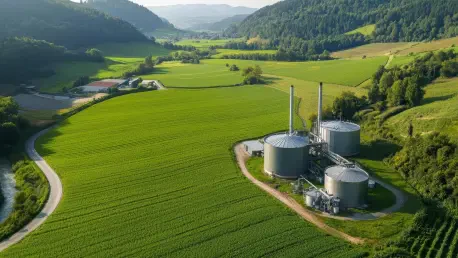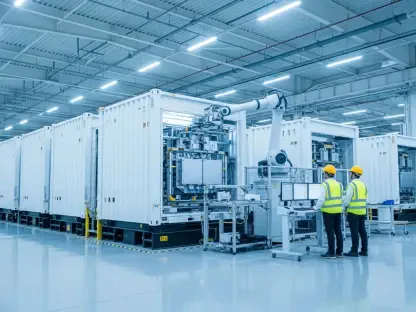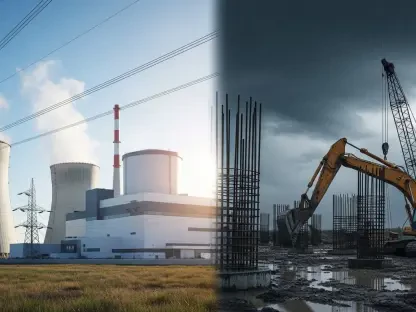Imagine a rural landscape in Haryana, India, where traditional cow shelters, known as gaushalas, are not just sanctuaries for cattle but also hubs of renewable energy production. With thousands of gaushalas dotting the state, the potential to harness biogas from cow dung offers a groundbreaking solution to energy challenges in these rural settings, promising to transform operational costs and environmental impact. This technology positions gaushalas as pioneers of sustainability. The following review delves into how biogas systems are reshaping these shelters, exploring their technical intricacies, benefits, and the path forward.
Technical Breakdown of Biogas Systems
Understanding the Production Mechanism
Biogas technology hinges on the process of anaerobic digestion, where cow dung is broken down by microorganisms in an oxygen-free environment within a digester. This process yields biogas, primarily methane, which serves as a renewable fuel for cooking, heating, or even generating electricity. In the context of gaushalas, the abundance of raw material makes this an ideal solution, with small to medium-sized plants producing enough energy to meet daily needs.
The efficiency of these systems varies based on the scale of operation. Larger gaushalas with hundreds of cattle can support industrial-grade digesters, while smaller shelters might opt for compact, family-sized units. Scalability remains a key advantage, allowing customization to match the specific energy demands and dung availability of each shelter.
Infrastructure and Setup Essentials
Setting up a biogas plant in a gaushala requires a well-designed digester, gas storage tanks, and pipelines for distribution. Maintenance is critical to ensure consistent performance, involving regular checks for leaks and proper mixing of dung with water to optimize digestion. Space constraints in smaller shelters can pose challenges, necessitating innovative designs that maximize output in limited areas.
The financial aspect of installation often deters initial adoption, with costs ranging significantly based on capacity. However, government subsidies in Haryana have played a pivotal role in easing this burden. Support programs and grants are increasingly available, encouraging gaushala operators to invest in this technology as a long-term cost-saving measure.
Recent Advancements and Policy Support
Haryana has emerged as a leader in promoting biogas technology within gaushalas, with state directives mandating the installation of plants across all shelters. Minister Shyam Singh Rana has spearheaded this initiative, emphasizing the dual goals of energy self-reliance and environmental conservation. This policy push aligns with broader rural development objectives, integrating renewable energy into everyday operations.
Technological innovations are also enhancing the appeal of biogas systems. Modern digester designs improve gas yield and reduce maintenance needs, while some gaushalas experiment with hybrid setups that combine solar and biogas energy. Such integrations showcase the potential for a diversified energy mix tailored to rural contexts.
State budgets from 2025 onward have allocated substantial funds to support these efforts, including financial incentives for installation and training programs for operators. This commitment reflects a strategic vision to position biogas as a cornerstone of agricultural sustainability, ensuring that gaushalas benefit from both policy backing and technological progress.
Practical Applications and Advantages
In gaushalas, biogas serves as a versatile energy source, powering kitchen stoves, heating systems, and even small generators for electricity. This reduces reliance on expensive fossil fuels, slashing operational expenses significantly. For many shelters in Haryana, the transition to biogas has become a financial lifeline, enabling them to redirect savings toward cattle care and facility improvements.
Beyond energy, the byproduct of anaerobic digestion—organic slurry—acts as a high-quality fertilizer. This resource supports sustainable agriculture by enriching soil without chemical inputs, creating a circular economy within rural communities. Farmers near gaushalas often benefit from access to this natural fertilizer, fostering stronger ties between shelters and local agriculture.
Specific case studies from Haryana highlight the transformative impact of these systems. Shelters that adopted biogas report not only cost reductions but also enhanced community goodwill, as they contribute to cleaner environments by curbing methane emissions from unmanaged dung. This dual benefit underscores the technology’s role in financial and ecological stability.
Challenges in Implementation
Despite its promise, biogas adoption faces several hurdles in rural settings. Technical issues, such as maintaining optimal digester conditions and addressing inconsistent dung supply due to fluctuating cattle numbers, can disrupt operations. Many gaushalas lack trained personnel to troubleshoot these problems, leading to downtime and reduced efficiency.
Financial barriers also loom large, as the upfront cost of installation remains prohibitive for smaller shelters, even with subsidies. Logistical challenges, including sourcing spare parts in remote areas, further complicate the scenario. Awareness among gaushala operators about long-term benefits is often limited, slowing the pace of adoption.
Haryana’s government has initiated steps to tackle these obstacles, rolling out training programs and fostering partnerships with technical institutes. Collaborations aim to build local expertise and provide ongoing support, ensuring that challenges do not derail the broader vision of energy independence for gaushalas.
Future Horizons for Biogas Integration
Looking ahead, the expansion of biogas technology across more gaushalas in Haryana holds immense potential to reshape rural energy landscapes. As adoption scales up, economies of scale could further lower costs, making systems accessible to even the smallest shelters. This growth trajectory could inspire neighboring states to replicate the model, amplifying impact.
Innovations on the horizon include integrating biogas with other renewable sources for hybrid energy solutions and enhancing dairy-biogas synergy through advanced cattle management practices. Such developments could maximize resource utilization, turning gaushalas into multifaceted sustainability hubs.
The long-term implications for rural economies are profound, with biogas poised to bolster energy security and environmental conservation. By reducing dependence on external energy sources and promoting organic farming, this technology could drive economic empowerment and resilience in agricultural communities, setting a precedent for sustainable rural development.
Reflecting on the Journey and Next Steps
The exploration of biogas technology in Haryana’s gaushalas reveals a powerful tool for sustainability and economic independence. Its ability to convert waste into energy and fertilizer stands out as a game-changer, while policy support plays a crucial role in overcoming initial barriers. Challenges persist, yet the state’s proactive measures offer a blueprint for progress.
Moving forward, stakeholders should prioritize expanding training initiatives to build local capacity and ensure system reliability. Investment in research for cost-effective, compact digesters tailored to small gaushalas could accelerate adoption. Additionally, fostering community engagement to highlight environmental and financial gains will be vital in sustaining momentum, paving the way for a greener, self-reliant rural future.









